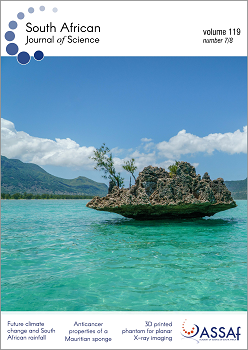Land cover change in marginalised landscapes of South Africa (1984–2014): Insights into the influence of socio-economic and political factors
DOI:
https://doi.org/10.17159/sajs.2023/10709Keywords:
rural landscapes, grassland, persistence, systematic and intensity analysis, uThukela Municipal DistrictAbstract
Rural landscapes in South Africa experience high conversion rates due to intense land use; however, the changes are site specific and depend on the socio-economic and political history of the area. Land cover change (LCC) was assessed in response to socio-economic and political factors in uThukela Municipal District, KwaZulu-Natal, using Landsat imagery from 1984 to 2014, while making comparisons to other studies in South Africa. Socio-economic/political data were used to gain insights into the observed LCC patterns. Land cover was classified using a random forest classifier, and accuracies ranging from 87% to 92% were achieved. Systematic and intensity analysis methods were used to describe patterns, rates, and transitions of LCC in Imbabazane (ILM) and Okhahlamba (OLM) local municipalities. The results showed a reduced rate of change intensity from 3.4% to 0.9% in ILM and from 3.1% to 1.1% in OLM between 1984 and 2014. Grassland was persistent, covering over 70% in both local municipalities between 1984 and 2014. Although persistent, grassland experienced respective losses of 3.7% and 14.3% in both observation periods in ILM and of 10.2% and 13.3% in OLM. During the analysis period, settlements and cropland gained actively in both local municipalities. The changes represent a degree of population, local authority, and people’s perception as influencers of land use and LCC. It is therefore argued that socio-economic and political changes can potentially influence land use and LCC; however, natural ecosystems can persist under those conditions, and this requires more research efforts.
Significance:
This study contributes towards a growing knowledge and understanding of land cover change studies in marginalised landscapes in South Africa. The findings enforce the notion that natural vegetation systems can be altered by human-induced land use such as expansion of settlement and commercial agricultural. We show that in recent times there has been a decline in the overall rate of land cover conversion, and a high persistence of grassland amid global change, although the quality of the vegetation needs further research. We argue that the changes observed in marginalised landscapes are potentially driven by socio-economic and political dynamics.
Downloads
Published
Issue
Section
License

All articles are published under a Creative Commons Attribution 4.0 International Licence
Copyright is retained by the authors. Readers are welcome to reproduce, share and adapt the content without permission provided the source is attributed.
Disclaimer: The publisher and editors accept no responsibility for statements made by the authors
How to Cite
- Abstract 424
- PDF 574
- EPUB 84
- XML 118
- Supplementary material 96
Funding data
-
National Research Foundation
Grant numbers 99289;SFH180514329246












.png)